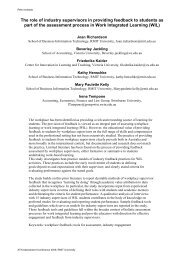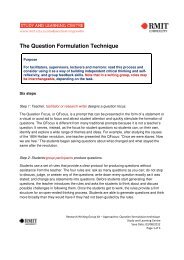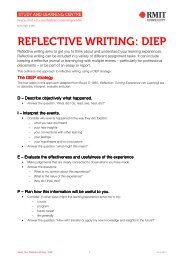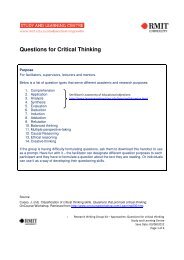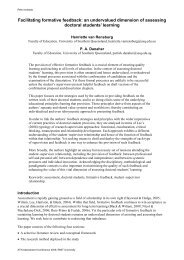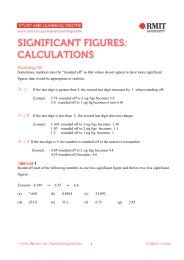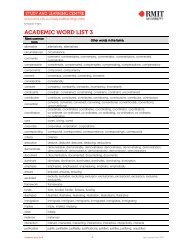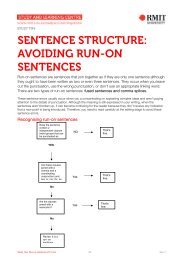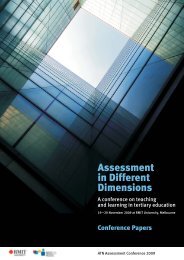student feedback and leadership - Office for Learning and Teaching
student feedback and leadership - Office for Learning and Teaching
student feedback and leadership - Office for Learning and Teaching
You also want an ePaper? Increase the reach of your titles
YUMPU automatically turns print PDFs into web optimized ePapers that Google loves.
Part A: Developing a Distributed Leadership Model - Secton 3: Building Leadership Capacity<br />
The School of Economics, Finance <strong>and</strong> Marketing ART:<br />
––<br />
An audience response system using mobile phone technology to give<br />
instant <strong>feedback</strong> to <strong>student</strong>s on their underst<strong>and</strong>ing of key concepts<br />
<strong>and</strong> their per<strong>for</strong>mance relative to their peers was introduced.<br />
––<br />
‘Drop-in sessions’ were scheduled as weekly events<br />
to supplement lectures.<br />
––<br />
Multimedia exercises were designed to relate business statistics<br />
to real-world events.<br />
––<br />
Podcasts were used to articulate key concepts <strong>and</strong> provide <strong>feedback</strong><br />
on assessment pieces.<br />
––<br />
Demonstration lectures were reduced in size from 120 <strong>student</strong>s<br />
to a maximum of 80 <strong>student</strong>s <strong>and</strong> the A lecture group of 600 was split<br />
into two groups of 300.<br />
––<br />
The content of one course was significantly redesigned <strong>and</strong> supported<br />
by AV materials to link “real world” relevance of materials.<br />
In addition to the variety of changes introduced by the ARTs, action was taken<br />
by the Project Team to consolidate the <strong>leadership</strong> capacity building that had<br />
begun in earlier cycles. This included:<br />
––<br />
An invitation to Project Team members to attend, in the second week<br />
of semester, large classes to experience first-h<strong>and</strong> service-related<br />
problems <strong>for</strong> teaching. Project Team members identified a range<br />
of problems including; lighting, noise <strong>and</strong> acoustics in the venues,<br />
lack of internet access, distance between lecturer <strong>and</strong> <strong>student</strong>s that<br />
makes engagement with the <strong>student</strong>s impossible, lack of desktops<br />
<strong>for</strong> <strong>student</strong>s.<br />
––<br />
Discussions in the Project Team that followed these visits resulted<br />
in significant changes to the practices of service providers aimed<br />
at consolidating improvements.<br />
Service providers were extremely positive about the opportunity this<br />
experience gave them to not only talk to staff directly about the problems<br />
they face, but also to experience first h<strong>and</strong> the challenges staff <strong>and</strong> <strong>student</strong>s<br />
were experiencing.<br />
The fourth Plenary was designed to share in<strong>for</strong>mation on the systematic<br />
changes that were being made to consolidate improvements in service<br />
provision. In addition to the usual attendees to the plenary sessions, particular<br />
invitations were sent to Heads of School, Deans Academic Development,<br />
PVC’s, School <strong>Teaching</strong> <strong>and</strong> <strong>Learning</strong> Directors <strong>and</strong> Chairs, College<br />
IT Managers in order to further disseminate experience.<br />
Page 53



